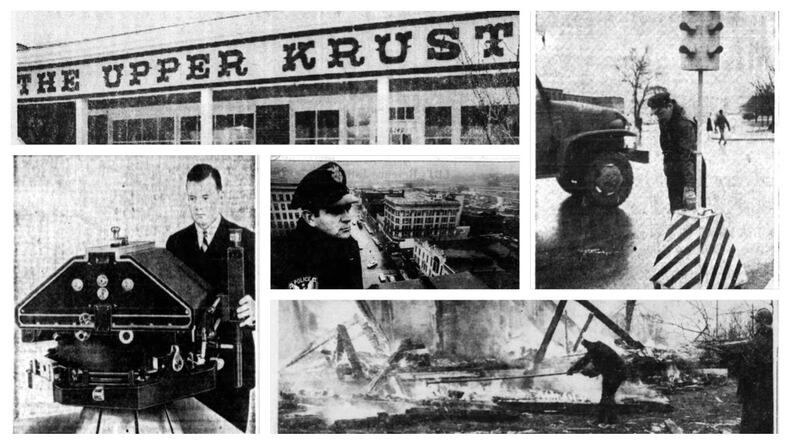Here’s a look at some stories from the week of Jan. 14-20.
Jan. 19, 1936: Meeting to discuss Air Corps photography held in Dayton
A meeting of seven officers and one civilian was held in Dayton to discuss Air Corp photography for use in aerial mapping.
In Alaska, for the first time anywhere, mass flying was employed in an aerial photograph survey.
Board members had gathered to view sample prints and a plotted map of 35,000 square miles of Alaska, developed during and after a mass flight of 10 Martin bombers from Washington, D.C. to Fairbanks, Alaska, by way of Dayton 18 months previous.
Five planes flying eight miles apart at 16,000 feet altitude covered a strip 400 miles long in seven hours and 45 minutes.
Prints made on the Alaska flight filled half a freight car.
Among the group was Capt. Albert W. Stevens, who had recently returned to Wright Field following a record stratosphere flight to 72,395 feet. Stevens was known for taking the first photograph of the Earth in a way that the horizon’s curvature was visible. Stevens also took the first photograph of the Moon’s shadow projected onto the Earth during a solar eclipse
Jan. 15, 1946: Picket Frigidaire, Delco - Hundreds march in strike lines as work cease
Dayton’s largest organized labor body, the United Electrical, Radio and Maintenance Workers (UE-CIO), established picket lines at plants of Frigidaire and Delco Products divisions of General Motors.
Hundreds of strikers marched in the picket lines at the plants in a mass labor demonstration unprecedented in Dayton. About 75 former servicemen, some in uniform, participated in the picketing.
In addition to picket lines at Frigidaire plants in Dayton and Moraine, and at the main Delco plant, strikers also paraded before the Lorenz Publishing Co. building on East Third Street, where first-floor offices are occupied by Delco.
The union was asking for a $2-a-day increase in wages and refused to accept a $1.08-a-day increase offered by management.
Jan. 14, 1948: Wright Field tests new portable traffic lights
Looking for a solution to traffic issues, new portable traffic lights were being tested at Wright Field.
The new development represented the culmination of a year of research work and construction by laboratory workers at the field.
Standing approximately eight feet in height and weighing about 100 pounds, the portable traffic light had the normal, red, amber and green bulbs seen in other systems. The lights were set for red and green to last 30 seconds and amber five seconds.
The lights were activated by a 24-volt aircraft battery which had a life of about 40 hours under normal conditions.
The field’s ground and safety crew put out 12 of the portable lights to be used during the evening rush hour periods. During the day they were placed off the road near intersections and wheeled into position before rush hour, five days a week.
As far as traffic control, Captain R.I. Johnson reported that the lights were not perfect but exceeded expectations.
Jan. 14, 1956: Firemen burn historic old Jonathan Whipp house
The last chapter in the history of a Washington Twp. landmark was written when the former Jonathan Whipp house, believed to have been built in 1842, was burned by Washington Twp. firemen.
Jonathan Whipp was a farmer and blacksmith for the area. He originally owned the 137-acre tract upon which the house sat.
A surviving family member described it as a “warm” structure with an inviting wide veranda on three sides with four huge pine and other trees standing in the yard, contributing to a gracious and spacious atmosphere. It was owned by the Whipp family for over 100 years.
The house, located at the southeast corner of Whipp Road and St. Rt. 48, was last owned by C.H. Huber, who had been renting it out since 1952.
The house was heavily damaged in a tornado the previous fall and went without a roof since then.
Workmen began razing the house, but the demolition task was later turned over to firemen.
Jan. 18, 1976: Third Upper Krust to open
Upper Krust, a local sandwich business started by Jack Rouda, was moving south and opening a third Upper Krust in Washington Square shopping center in Centerville.
His other two stores were at 1919 N Main St. and at 142 N Main. The downtown restaurant was relocated from Courthouse Square in 1975.
The 102-seat restaurant was to have all of the menu and decorative features as the other two. An added feature was to be an old-fashioned gazebo in the middle of the restaurant where customers would be able to hang their coats.
“An 1890s New York delicatessen is the image we try to shoot for,” said new manager Douglas Gowdy
Upper Krust specialized in exotic sandwiches, soups and desserts.
The Washington Square shopping center also featured the Washington Square Cinema, an A&P supermarket, clothing stores, a bank and a library.
Upper Krust has been closed since the early 2000s.
About the Author






